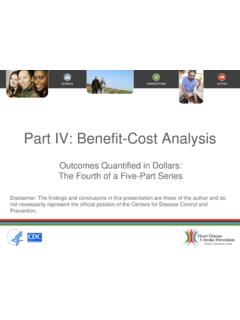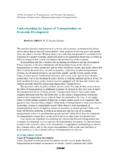Transcription of How does foreign direct investment affect economic growth?
1 Journal of International Economics 45 (1998) 115 135. How does foreign direct investment affect economic growth? 1. E. Borensztein a , *, J. De Gregorio b , J-W. Lee c a International Monetary Fund, Research Department, Washington DC 20431 USA. b Center for Applied Economics, Department of Industrial Engineering, Universidad de Chile, Santiago, Chile c Economics Department, Korea University and NBER, Seoul 136 -701 Korea Received 21 February 1996; received in revised form 24 February 1997; accepted 20 May 1997. Abstract We test the effect of foreign direct investment (FDI) on economic growth in a cross-country regression framework, utilizing data on FDI flows from industrial countries to 69 developing countries over the last two decades. Our results suggest that FDI is an important vehicle for the transfer of technology, contributing relatively more to growth than domestic investment .
2 However, the higher productivity of FDI holds only when the host country has a minimum threshold stock of human capital. Thus, FDI contributes to economic growth only when a sufficient absorptive capability of the advanced technologies is available in the host economy. 1998 Elsevier Science Keywords: foreign direct investment ; economic growth; Cross-country regression frame- work; Developing countries *Corresponding author: Tel.: 11 202 6237679; Fax: 11 202 6234740; e-mail: 1. We are grateful for comments from Robert Barro, Elhanan Helpman, Boyan Jovanovic, Mohsin Khan, Se-Jik Kim, Donald Mathieson, Sergio Rebelo, Jeffrey Sachs, Peter Wickham, and two anonymous referees. Comments by participants in seminars at 1995 World Congress of the Econo- metric Society, Korean Macroeconomics Workshop, Kobe University, and Osaka University were very helpful.
3 This paper was partially prepared while Jose de Gregorio and Jong-Wha Lee were at the Research Department, International Monetary Fund. Any opinions expressed are only those of the authors and not those of the institutions with which the authors are affiliated. 0022-1996 / 98 / $ 1998 Elsevier Science All rights reserved. PII S0022-1996( 97 )00033-0. 116 E. Borensztein et al. / Journal of International Economics 45 (1998) 115 135. 1. Introduction Technology diffusion plays a central role in the process of economic In contrast to the traditional growth framework, where technological change was left as an unexplained residual, the recent growth literature has highlighted the dependence of growth rates on the state of domestic technology relative to that of the rest of the world. Thus, growth rates in developing countries are, in part, explained by a catch-up' process in the level of technology.
4 In a typical model of technology diffusion, the rate of economic growth of a backward country depends on the extent of adoption and implementation of new tech- nologies that are already in use in leading countries. Technology diffusion can take place through a variety of channels that involve the transmission of ideas and new technologies. Imports of high-technology products, adoption of foreign technology and acquisition of human capital through various means are certainly important conduits for the international diffusion of Besides these channels, foreign direct investment by multinational corporations (MNCs) is considered to be a major channel for the access to advanced technologies by developing countries. MNCs are among the most technologically advanced firms, accounting for a substantial part of the world's research and development (R and D) investment .
5 Some recent work on economic growth has highlighted the role of foreign direct investment in the technological progress of developing countries. Findlay (1978) postulates that foreign direct investment increases the rate of technical progress in the host country through a contagion' effect from the more advanced technology, management practices, etc. used by the foreign firms. Wang (1990) incorporates this idea into a model more in line with the neoclassical growth framework, by assuming that the increase in knowledge' applied to production is determined as a function of foreign direct investment (FDI). The purpose of this paper is to examine empirically the role of FDI in the process of technology diffusion and economic growth in developing countries. We motivate the empirical work by a model of endogenous growth, in which the rate of technological progress is the main determinant of the long-term growth rate of income.
6 Technological progress takes place through a process of capital deepen- ing' in the form of the introduction of new varieties of capital goods. MNCs possess more advanced knowledge', which allows them to introduce new capital 2. Previous research on technology diffusion includes Nelson and Phelps (1966), Jovanovic and Rob (1989), Grossman and Helpman (1991) (chapters 11 and 12), Segerstrom (1991) and Barro and Sala-i-Martin (1995) (chapter 8). 3. See Easterly et al. (1994) for a framework incorporating the roles of technology adoption through international trade and human capital accumulation as determinants of economic growth.! E. Borensztein et al. / Journal of International Economics 45 (1998) 115 135 117. goods at lower However, the application of this more advanced technologies also requires the presence of a sufficient level of human capital in the host economy.
7 The stock of human capital in the host country, therefore, limits the absorptive capability of a developing country, as in Nelson and Phelps (1966), and Benhabib and Spiegel (1994). Hence, the model highlights the roles of both the introduction of more advanced technology and the requirement of absorptive capability in the host country as determinants of economic growth, and suggests the empirical investigation of the complementarity between FDI and human capital in the process of productivity growth. We test the effect of FDI on economic growth in a framework of cross-country regressions utilizing data on FDI flows from industrial countries to 69 developing countries over the last two Our results suggest that FDI is in fact an important vehicle for the transfer of technology, contributing to growth in larger measure than domestic investment .
8 Moreover, we find that there is a strong complementary effect between FDI and human capital, that is, the contribution of FDI to economic growth is enhanced by its interaction with the level of human capital in the host country. However, our empirical results imply that FDI is more productive than domestic investment only when the host country has a minimum threshold stock of human capital. The results are robust to a number of alternative specifications, which control for the variables usually identified as the main determinants of economic growth in cross-country regressions. This sensitivity analysis along the lines of Levine and Renelt (1992) shows a robust relationship between economic growth, FDI and human capital. We also investigate the effect of FDI on domestic investment , namely, whether there is evidence that the inflow of foreign capital crowds out' domestic investment .
9 In principle, this effect could have either sign: by competing in product and financial markets MNCs may displace domestic firms; conversely, FDI may support the expansion of domestic firms by complementarity in production or by increasing productivity through the spillover of advanced Our results are supportive of a crowding-in effect, that is, a one-dollar 4. It is most likely that a foreign firm that decides to invest in another country enjoys lower costs than its domestic competitors deriving from higher productive efficiency. The higher efficiency may owe partly to the combination of foreign advanced management skills with domestic labor and inputs. Several micro-studies have attempted to assess empirically the impact of FDI on the domestic economy. (See, for example, United Nations (1992), Aitken and Harrison (1993), and references therein).
10 5. De Gregorio (1992) shows, in a panel data of 12 Latin American countries, that FDI is about three times more efficient than domestic investment . Blomstrom et al. (1992) also find a strong effect of FDI. on economic growth in LDCs. 6. An additional factor could be that policies offering preferential tax treatment and other incentives to induce inward FDI may introduce a distortion affecting domestic investment . If such distortion between the return to foreign and domestic capital were significant, it could have a large negative effect on growth, as in Easterly (1993). 118 E. Borensztein et al. / Journal of International Economics 45 (1998) 115 135. increase in the net inflow of FDI is associated with an increase in total investment in the host economy of more than one dollar, but do not appear to be very robust.








